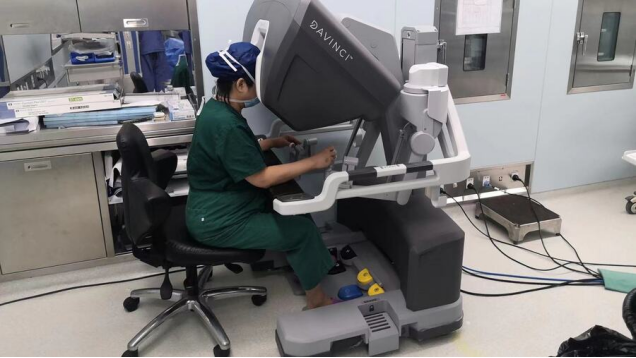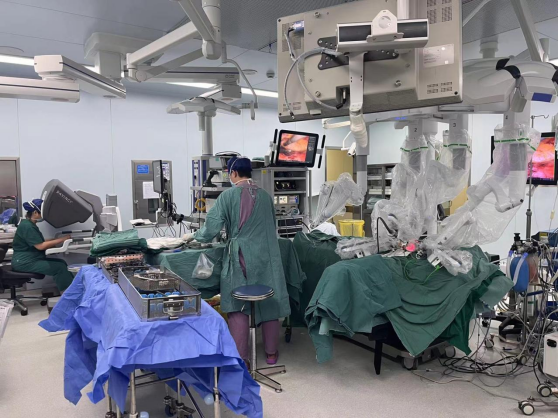- News
Considering Aesthetic and Quality-of-life Needs, Shanghai's First Fourth-generation Da Vinci-assisted Breast Reconstruction Completed at Shanghai General Hospital
Link of the Original Article:
https://www.shobserver.com/staticsg/res/html/web/newsDetail.html?id=554415
The patient strongly wished to preserve her breast shape and also did not intend to accept the autologous flap reconstruction surgery, which would be more traumatic.

Recently, the breast surgery team led by Professor Li Zhu, director of the Department of Thyroid and Breast Surgery (North) of the General Surgery Center of Shanghai General Hospital, performed Shanghai's first fourth-generation da Vinci robot-assisted total subcutaneous breast gland excision + axillary sentinel lymph node biopsy + immediate breast reconstruction by prosthesis for a breast cancer patient, relying on the newly established "Comprehensive Breast Tumor Clinic (COC)" platform, adopted the "robot-assisted precision minimally invasive" surgical concept, with the assistance of the department of medical ultrasonics, radiology, pathology, oncology, clinical pharmacy and other departments. The operation went smoothly and the patient was satisfied with the postoperative effect and the reconstruction.
It is understood that more than 80% of breast cancer patients, especially early stage cases, can basically reach the cure standard after standardized diagnosis and treatment. Therefore, the patients' demands for postoperative appearance of the breast and quality of life are getting higher. Shanghai General Hospital has recently officially established the "Comprehensive Diagnosis and Treatment Center for Breast Tumors", which provides comprehensive treatment for breast tumor patients while adhering the concept of humanistic care and whole life cycle health management, striving to provide both physical and psychological care for patients.
Ms. Tong, a 56-year-old teacher, has been diagnosed with "breast ductal cancer in situ (intermediate grade)" in another hospital. Due to the large range of the tumor and the molybdenum target indicated that diffuse dotted cluster calcification in the outer upper quadrant of the left breast, she could not be performed breast-conserving surgery and had to undergo total mastectomy, which was Unacceptable for Ms. Tong, who wanted to preserve the breast. Therefore, she came to Shanghai to seek help from the team of Comprehensive Diagnosis and Treatment Center for Breast Tumors at Shanghai General Hospital.
Faced with the patient's strong desire to preserve the shape of her breast and to refuse the more traumatic autologous flap reconstruction surgery, the breast tumor COC team worked hard to find a treatment plan for the patient that balanced the therapeutic effect and aesthetics as much as possible. Members of the department of medical ultrasonics, radiology and nuclear medicine carefully evaluated the efficacy of the patient's neoadjuvant therapy, experts from pathology and oncology analyzed the biological characteristics of the tumor, and clinical pharmacology departments were involved in targeted drug supply and side effect monitoring. Finally, after thorough communication with the patient, the breast cancer COC team decided to carry out a robot-assisted total subcutaneous breast gland excision + axillary anterior lymph node biopsy + immediate breast reconstruction by breast prosthesis. The surgery was performed to reshape the patient's breast while minimizing the trauma caused by conventional surgery, making the surgical incision smaller and more concealed, and further improving the aesthetics of appearance.

On the day of surgery, Prof. Li Zhu led four team members, Shijun Xiang, Zhaoqi Zhang, Yan Fang, and Shuning Ding, with the active cooperation of the anesthesiology department and the nursing team in the operating room, performed a fourth-generation da Vinci robot-assisted subcutaneous breast gland excision + axillary sentinel lymph node biopsy + immediate breast reconstruction by breast prosthesis on Ms. Tong.
Since there is no natural cavity in the breast, it is more difficult to operate a laparoscopic surgery, especially when separating the lower quadrant of the anterior space of the breast, the laparoscopic instruments have less freedom in the narrow space and are obstructed by the shoulder and arm, thus making the separation operation relatively difficult. The da Vinci robot can ensure precise and efficient tumor removal and minimize the psychological and physical trauma caused by the surgery: On one hand, the surgical incision is smaller than the open surgical incision, the incision is hidden in the axilla, and there is no wound on the surface of the breast, that not only makes the appearance more beautiful and reduces the psychological burden on the patient, but also avoids the risk of excessive tension in the incision leading to incision cracking and prosthetic exposure. On the other hand, the robot-assisted surgical vision is clearer and the anatomical structure of nerve and vessels could be revealed more accurate, especially for the protection of the intercostal brachial nerves and important vessels and nerves, which reduces the incidence of postoperative complications. In addition, previous prosthetic reconstruction surgeries were generally open surgery or laparoscopic-assisted, but in this surgery, the surgical team introduced robot-assisted surgery technology into breast surgery, rendering a more delicate and less traumatic surgical procedure, with mastectomy and reconstruction completed in one surgery, which also minimizes the patient's postoperative physical disability.
Prof. Li Zhu emphasized that it is not necessary for all patients to undergo robot-assisted surgery. It should be applied after fully communication with patients according to their conditions and the needs of the operation. "Innovations in technology are only means. Through various forms of surgery combined with postoperative MDT of breast cancer and the whole process of adjuvant treatment and management, ultimately benefiting patients is the goal that our team has been pursuing.”
Correspondents: Yang Hu, Yangzi Huang
